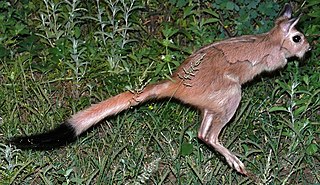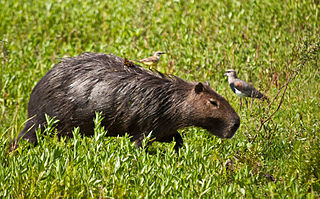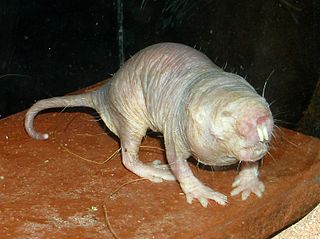
Phoberomys pattersoni is an extinct rodent that lived in the ancient Orinoco River delta around 8 million years ago. It was the second-largest of the roughly seven species of its genus. Like many other rodents, Phoberomys was a herbivore with high-crowned premolars and molars.

Pedetes is a genus of rodent, the springhares, in the family Pedetidae. Members of the genus are distributed across southern and Eastern Africa.

The genus Hydrochoerus contains two living and two extinct species of rodents from South America, the Caribbean island of Grenada, and Panama. Capybaras are the largest living rodents in the world. The genus name is derived from the Greek ὕδωρ plus χοίρος.

Synaptomys is a genus of North American lemmings. These animals live in wet forested and open areas. They are small, cylindrical rodents with large heads and short ears, legs, and tails. They eat green vegetation such as grasses and sedges. They are often found in colonies.

Zapodidae, the jumping mice, is a family of mouse-like rodents in North America and China.

The rodent parvorder or infraorder Phiomorpha comprises several living and extinct families found wholly or largely in Africa. Along with Anomaluromorpha and perhaps the extinct Zegdoumyidae, it represents one of the few early colonizations of Africa by rodents.

The term Hystricomorpha has had many definitions throughout its history. In the broadest sense, it refers to any rodent with a hystricomorphous zygomasseteric system. This includes the Hystricognathi, Ctenodactylidae, Anomaluridae, and Pedetidae. Molecular and morphological results suggest the inclusion of the Anomaluridae and Pedetidae in Hystricomorpha may be suspect. Based on Carleton & Musser 2005, these two families are discussed here as representing a distinct suborder Anomaluromorpha.

Anomaluromorpha is a clade that unites the anomalures, springhares, and zenkerella. It has alternately been designated as either a suborder or infraorder. Most recently, Carleton & Musser 2005 recognized it as one of five suborders of rodents.

The Eocardiidae are an extinct family of caviomorph rodents from South America. The family is probably ancestral to the living family Caviidae, which includes cavies, maras, and capybaras and their relatives. McKenna and Bell (1997) divided eocardiids into two subfamilies, Luantinae for two of the oldest genera and Eocardiinae for remaining genera. Kramarz (2006) has recommended the abandonment of these subfamilies, as the genera placed in Luantinae appear to represent basal eocardiids, rather than a specialized side branch. The latter hypothesis had been proposed by Wood and Patterson (1959).

Ailuravus is a genus of prehistoric rodents in the family Ischyromyidae.
The Casamayoran age is a period of geologic time within the Early Eocene epoch of the Paleogene, used more specifically within the South American land mammal age (SALMA) classification. It follows the Itaboraian and precedes the Mustersan age.
The Divisaderan age is a South American land mammal age, covering a period of geologic time within the Middle and Late Eocene epochs of the Paleogene. It follows the Mustersan age and is followed by the Tinguirirican age.
The Tinguirirican age is a period of geologic time within the Late Eocene and Early Oligocene epochs of the Paleogene, used more specifically within the SALMA classification in South America. It follows the Divisaderan and precedes the Deseadan age.
The Deseadan age is a period of geologic time within the Oligocene epoch of the Paleogene to the Early Miocene epoch of the Neogene, used more specifically within the SALMA classification of South America. It follows the Tinguirirican and precedes the Colhuehuapian age.
The Huayquerian age is a period of geologic time within the Late Miocene epoch of the Neogene, used more specifically within the SALMA classification. It follows the Mayoan and precedes the Montehermosan age.
Heteromyinae is a subfamily of rodents in the family Heteromyidae, commonly known as spiny pocket mice. It contains a single extant genus, Heteromys, as well as the extinct genera Diprionomys and Metaliomys. Heteromys was recently enlarged by inclusion of the members of formerly recognized heteromyine genus Liomys, which was found to be paraphyletic.

Miocochilius is an extinct genus of small notoungulate mammals (typotheres) native to South America. The genus lived during the Middle Miocene epoch. The genus contains two described species, the type species M. anomopodus described in 1953 by Ruben Arthur Stirton and M. federicoi, described and included in the genus by Darin A. Croft.

Anagalidae is an extinct family of mammals closely related to rodents and lagomorphs. Members of the family are known from Paleocene to Oligocene deposits in China and Mongolia.
Astigalidae is an extinct family of mammals related to the rodents and lagomorphs. Members of the family are known from the Paleocene and Eocene of China.











